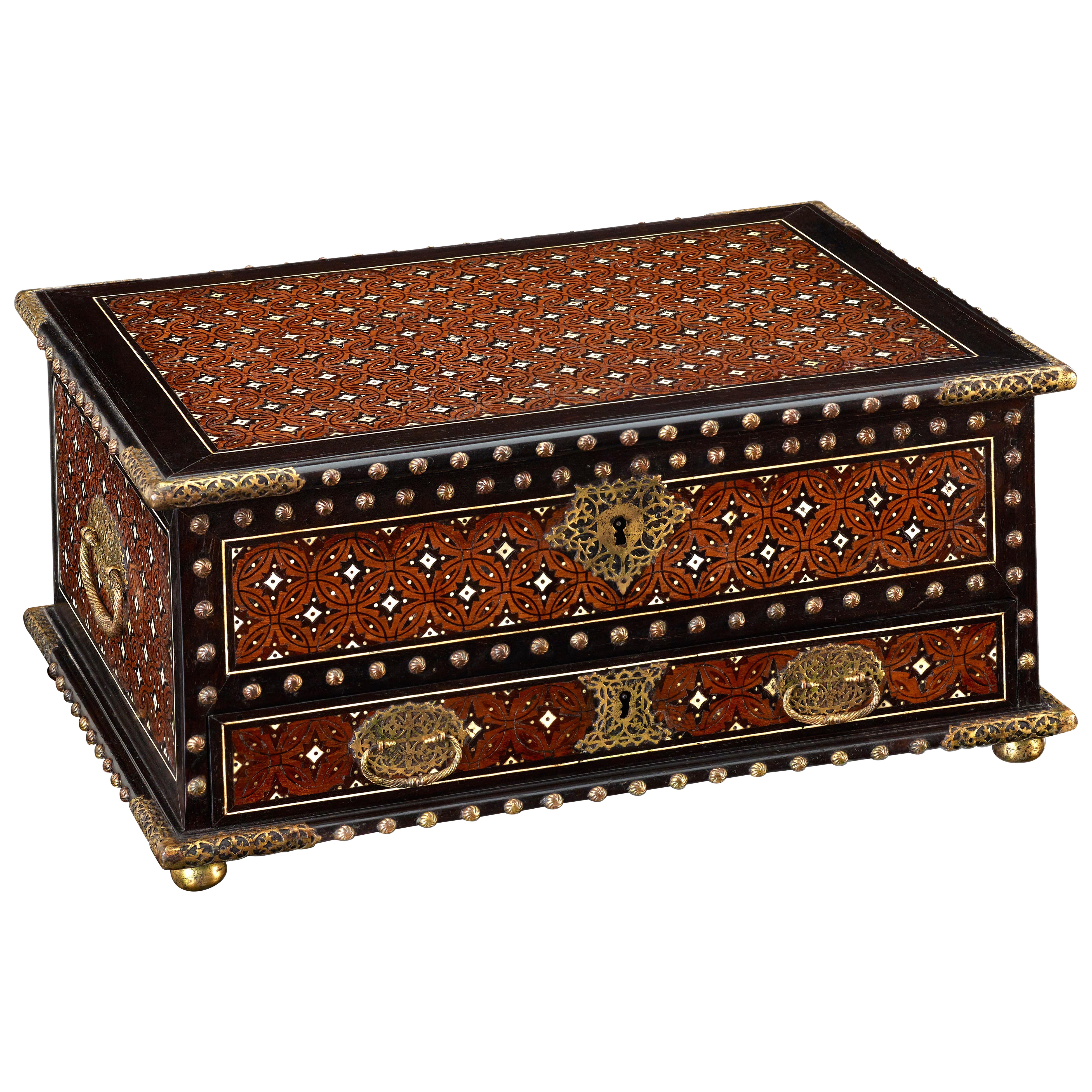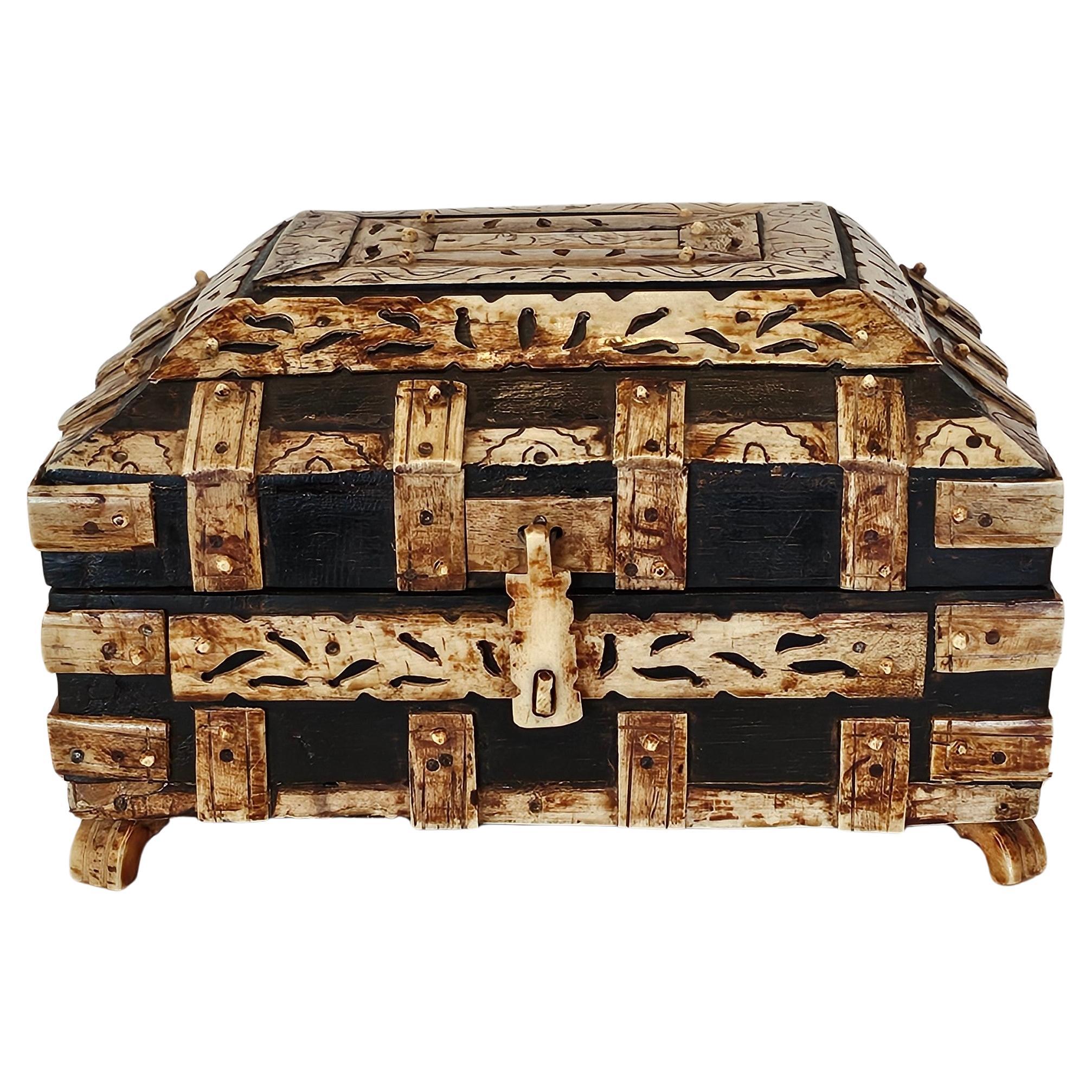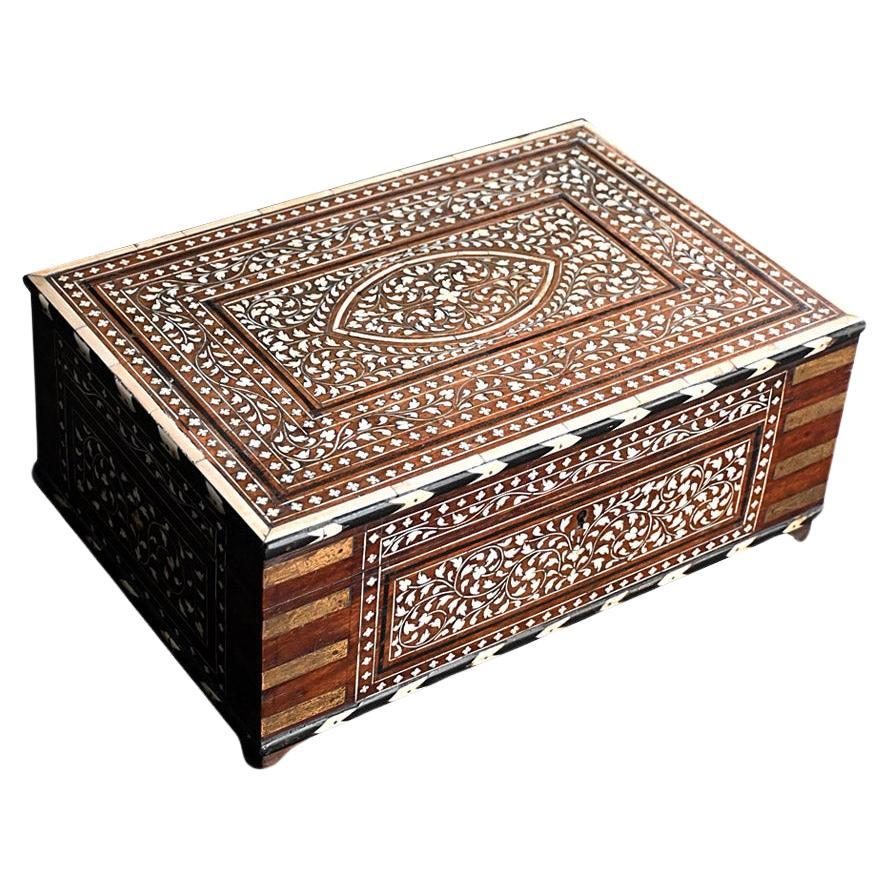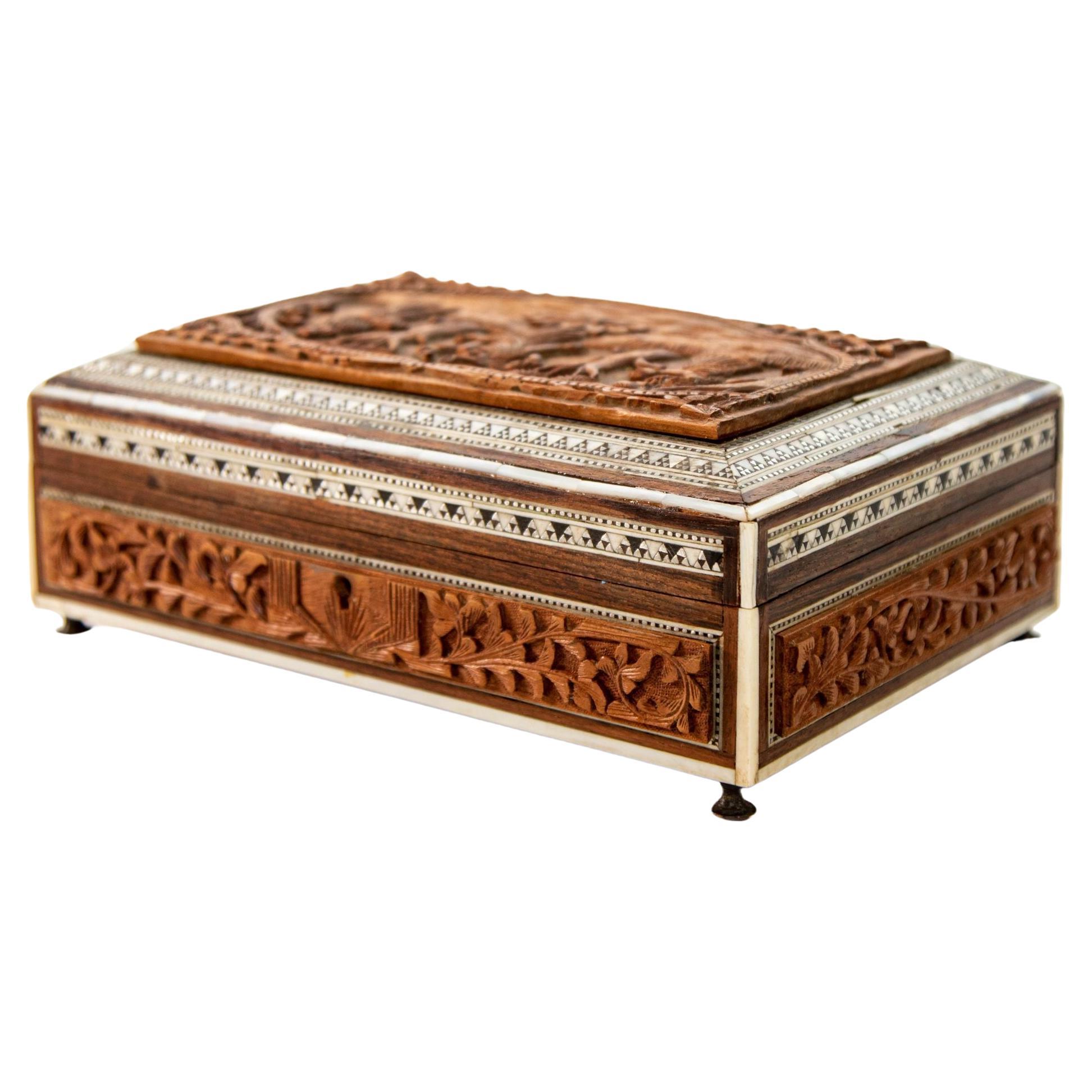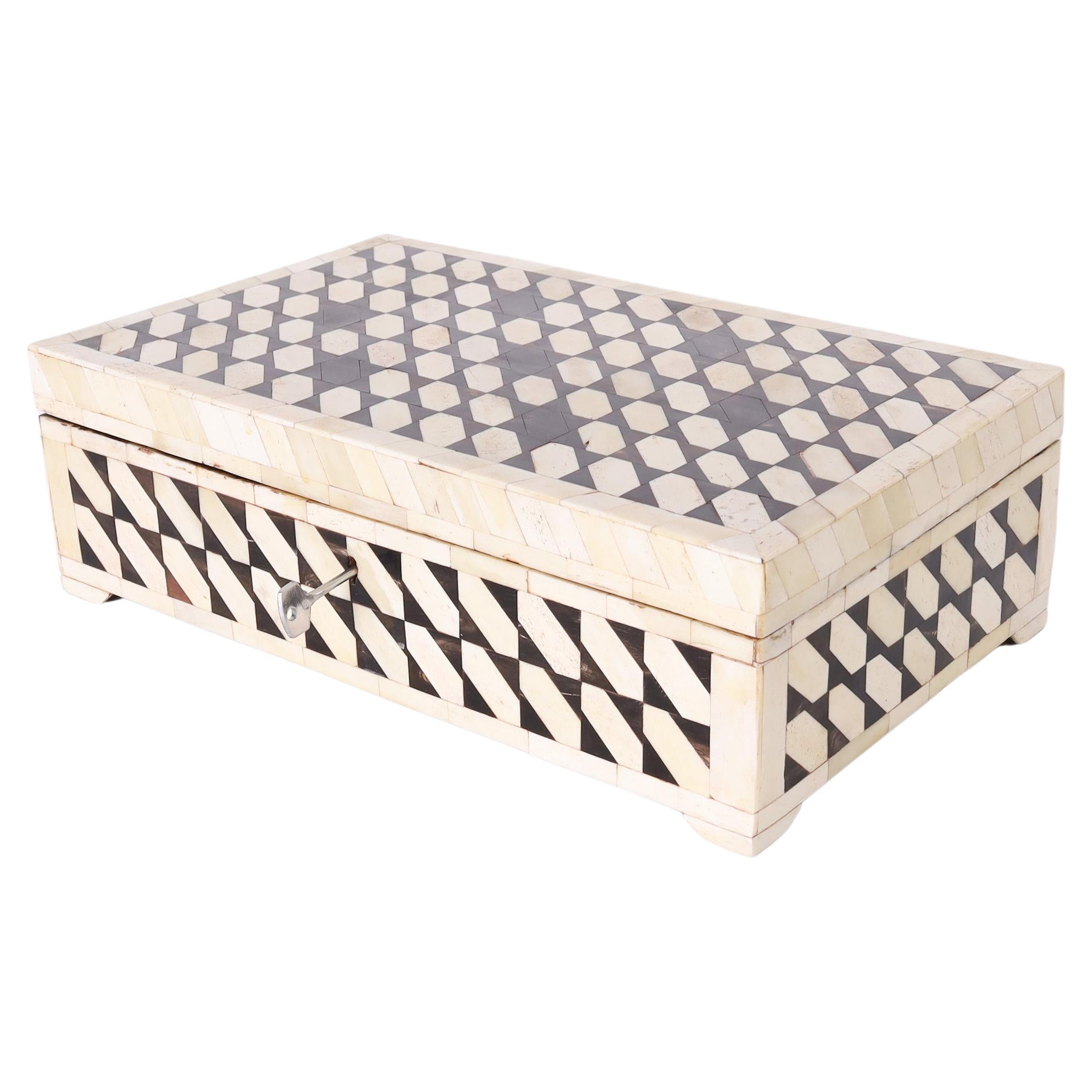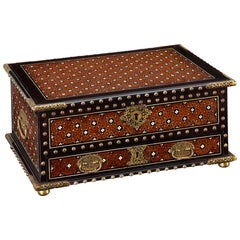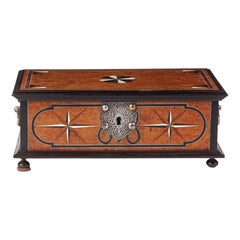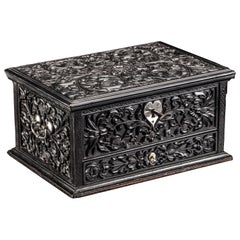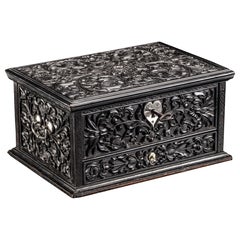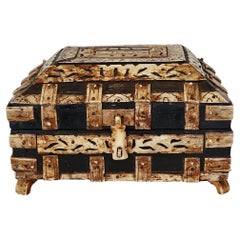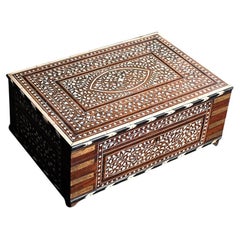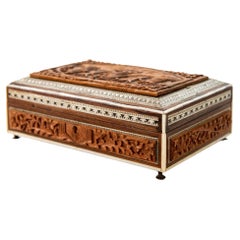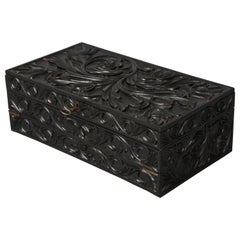Items Similar to 18th century Dutch-Colonial ‘Vizagapatam’ pen-engraved bone inlaid ebony box
Want more images or videos?
Request additional images or videos from the seller
1 of 9
18th century Dutch-Colonial ‘Vizagapatam’ pen-engraved bone inlaid ebony box
$41,350.84
£30,995.02
€35,000
CA$56,809.03
A$63,421.93
CHF 33,232.14
MX$776,346.73
NOK 422,048.51
SEK 397,938.16
DKK 266,432.77
Shipping
Retrieving quote...The 1stDibs Promise:
Authenticity Guarantee,
Money-Back Guarantee,
24-Hour Cancellation
About the Item
A large Indian Colonial ‘Vizagapatam’ pen-engraved bone inlaid ebony box
Masulipatnam or Vizagapatam, 2nd half 18th century
H. 10.8 x W. 47 x D. 34 cm
There are a few similar document boxes with fine inlay of small flowers connected by curling vines, many of them with the coats-of-arms of high-ranking VOC-officials engraved on a plaque in the centre of the lid. These boxes have always been thought to have been made in Vizagapatam. However, recently Jan Veenendaal convincingly argued that Masulipatam, about 300 kilometres south of Vizagapatam, and a much more important trade post for the Dutch than Vizagapatam, is much more likely to be the place where this type of box was ordered by the Dutch (Jan Veenendaal, De herkomst van documentenkisten met Nederlandse heraldische wapens van hoge VOC- functionarissen in Azië, Aziatische Kunst, jaargang 49, nr.1, maart 2019, pg. 53-60). The most famous amongst these boxes are those made on order by Jan Albert Sichterman (c. 1736), the Falck family (c. 1735), Jacob Mossel (c. 1740), Galenus Mersen (c. 1740) and Jan van Oordt (c.1740). The present box does not have a family crest in the central oval medallion. However, instead, inside a double ring two lions rampant crowned, on both sides of a large decorative flowering plant, arguably relating to the Dutch national coat-of-arms.
- Dimensions:Height: 4.26 in (10.8 cm)Width: 18.51 in (47 cm)Depth: 13.39 in (34 cm)
- Style:Dutch Colonial (Of the Period)
- Materials and Techniques:
- Place of Origin:
- Period:
- Date of Manufacture:circa 1720-1740
- Condition:Wear consistent with age and use.
- Seller Location:Amsterdam, NL
- Reference Number:1stDibs: LU5458231950892
About the Seller
5.0
Recognized Seller
These prestigious sellers are industry leaders and represent the highest echelon for item quality and design.
Established in 1985
1stDibs seller since 2020
23 sales on 1stDibs
Typical response time: 2 hours
- ShippingRetrieving quote...Shipping from: Amsterdam, Netherlands
- Return Policy
Authenticity Guarantee
In the unlikely event there’s an issue with an item’s authenticity, contact us within 1 year for a full refund. DetailsMoney-Back Guarantee
If your item is not as described, is damaged in transit, or does not arrive, contact us within 7 days for a full refund. Details24-Hour Cancellation
You have a 24-hour grace period in which to reconsider your purchase, with no questions asked.Vetted Professional Sellers
Our world-class sellers must adhere to strict standards for service and quality, maintaining the integrity of our listings.Price-Match Guarantee
If you find that a seller listed the same item for a lower price elsewhere, we’ll match it.Trusted Global Delivery
Our best-in-class carrier network provides specialized shipping options worldwide, including custom delivery.More From This Seller
View AllAn Indo-Portuguese bone-inlaid ebony and teak writing box with gilt-brass mounts
Located in Amsterdam, NL
India, Goa, 17th century
The box, overall inlaid with a delicate pattern in ebony and bone in teak reserves bordered by brass-studded ebony, is of oblong shape. The corners, lock-pl...
Category
Antique 17th Century Indian Cabinets
Materials
Bone, Ebony, Teak
A highly refined Dutch-colonial Sri Lankan inlaid box with silver mounts
Located in Amsterdam, NL
Galle district, 18th century
The box is made of amboyna burr with inlays of ebony, bone and burr wood and has several interior compartments, all made with the utmost attention to de...
Category
Antique 18th Century Sri Lankan Decorative Boxes
Materials
Bone, Ebony, Amboyna
A Dutch colonial ebony box with silver mounts
Located in Amsterdam, NL
Batavia (Jakarta), or Sri Lanka, circa 1680-1720
The document or money box is densely carved with fine scrolling vines and lotus flowers. It has a charming heart- shapes silver lock...
Category
Antique Late 17th Century Indonesian Dutch Colonial Antiquities
Materials
Silver
A Dutch colonial ebony box with silver mounts
Located in Amsterdam, NL
Batavia (Jakarta), or Sri Lanka, circa 1680-1720
The document or money box is densely carved with fine scrolling vines and lotus flowers. It has a charming heart- shapes silver lock...
Category
Antique 17th Century Indonesian Antiquities
Materials
Silver
17th century colonial Sinhalese ebony two-door cabinet with silver mounts
Located in Amsterdam, NL
A splendid Dutch-colonial Sinhalese ebony two-door cabinet with silver mounts
Sri Lanka, Kandy, 2nd half 17th century, the mounts later
The cabinet with a central drawer with hidde...
Category
Antique 17th Century Sri Lankan Dutch Colonial Jewelry Boxes
Materials
Silver
Ebony Veneered Captain's Chest or Strong Box 'Coffre Fort', 17th Century
Located in Amsterdam, NL
A strongbox was a type of travelling chest and these types of boxes were more common in England than anywhere else where they were fabricated between 1660 and 1720. The earliest proo...
Category
Antique Late 17th Century Dutch Dutch Colonial Decorative Boxes
Materials
Brass
You May Also Like
Antique Vizagapatam India Table Box Ebonized Wood & Bone Carvings
Located in Forney, TX
Vizagapatam box, India, 19th century.
This highly decorative and unusual Anglo-Indian table box features rustic workmanship that adds to the character and charm of this unique Sout...
Category
Antique 19th Century Indian Anglo Raj Decorative Boxes
Materials
Bone, Wood
19th Century Hoshiarpur Inlaid Writing Box
Located in London, GB
19th Century Hoshiarpur Inlaid Writing Box
Quite simply, this is a stunning example of a 19th Century hand crafted Hoshiarpur inlaid writing box. The craftsmanship is quite amazing ...
Category
Antique 1870s Indian Early Victorian Decorative Boxes
Materials
Wood
Antique Anglo-Indian Vizagapatam Jewelry Inlaid Sadeli Footed Box
Located in North Hollywood, CA
Antique 19th century Anglo-Indian jewelry, trinket footed box, inlay with ebony, mosaic marquetry Sadeli work and a carved Hindu scene on top.
The box case is made from sandalwood wi...
Category
Early 20th Century Indian Anglo-Indian Decorative Boxes
Materials
Bone, Mother-of-Pearl, Wood
Ceylonese 'Sri Lankan' Ebony Writing Slope
Located in Greenwich, CT
Very fine early 19th century carved ebony writing slope, the exterior richly carved with foliate decoration, the interior profusely inlaid with bon...
Category
Antique Early 19th Century Sri Lankan Anglo-Indian Decorative Boxes
Materials
Bone, Ebony, Sandalwood
Anglo Indian Bone and Ebony Box
Located in Palm Beach, FL
Impressive Anglo Indian rectangular hinged box handcrafted in rosewood with inlaid bone and ebony in geometric designs and plenty of decorative appeal.
Category
21st Century and Contemporary Indian Anglo-Indian Decorative Boxes
Materials
Bone
19th Century Anglo-Indian Sadeli Inlaid Work Box Traveling Writing Desk
Located in Stamford, CT
A stunning camel bone, ebony and metal inlaid sadeli work box with portable writing desk, Bombay, circa 1850.
The sandalwood body of faceted rec...
Category
Antique Mid-19th Century Indian Anglo-Indian Decorative Boxes
Materials
Metal
